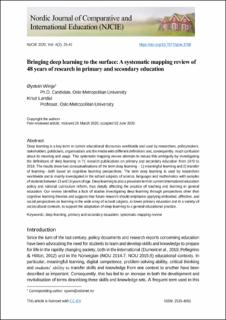| dc.contributor.author | Winje, Øystein | |
| dc.contributor.author | Løndal, Knut | |
| dc.date.accessioned | 2021-09-10T08:44:31Z | |
| dc.date.available | 2021-09-10T08:44:31Z | |
| dc.date.created | 2020-07-01T10:15:25Z | |
| dc.date.issued | 2020-07-01 | |
| dc.identifier.citation | Nordic Journal of Comparative and International Education (NJCIE). 2020, 4 (2), 25-41. | en_US |
| dc.identifier.issn | 2535-4051 | |
| dc.identifier.uri | https://hdl.handle.net/11250/2775150 | |
| dc.description.abstract | Deep learning is a key term in current educational discourses worldwide and used by researchers, policymakers, stakeholders, politicians, organisations and the media with different definitions and, consequently, much confusion about its meaning and usage. This systematic mapping review attempts to reduce this ambiguity by investigating the definitions of deep learning in 71 research publications on primary and secondary education from 1970 to 2018. The results show two conceptualisations of the term deep learning—1) meaningful learning and 2) transfer of learning—both based on cognitive learning perspectives. The term deep learning is used by researchers worldwide and is mainly investigated in the school subjects of science, languages and mathematics with samples of students between 13 and 16 years of age. Deep learning is also a prevalent term in current international education policy and national curriculum reform, thus deeply affecting the practice of teaching and learning in general education. Our review identifies a lack of studies investigating deep learning through perspectives other than cognitive learning theories and suggests that future research should emphasise applying embodied, affective, and social perspectives on learning in the wide array of school subjects, in lower primary education and in a variety of sociocultural contexts, to support the adaptation of deep learning to a general educational practice. | en_US |
| dc.language.iso | eng | en_US |
| dc.publisher | OsloMet - Storbyuniversitetet | en_US |
| dc.relation.ispartofseries | Nordic Journal of Comparative and International Education;Vol. 4 No. 2 (2020): General issue - Comparative and international education in a changing world | |
| dc.rights | Navngivelse 4.0 Internasjonal | * |
| dc.rights.uri | http://creativecommons.org/licenses/by/4.0/deed.no | * |
| dc.subject | Deep learning | en_US |
| dc.subject | Primary education | en_US |
| dc.subject | Secondary education | en_US |
| dc.subject | Systematic mapping reviews | en_US |
| dc.title | Bringing deep learning to the Surface: A systematic mapping review of 48 years of research in primary and secondary education | en_US |
| dc.type | Peer reviewed | en_US |
| dc.type | Journal article | en_US |
| dc.description.version | publishedVersion | en_US |
| dc.rights.holder | Copyright (c) 2020 Øystein Winje, Knut Løndal | en_US |
| cristin.ispublished | true | |
| cristin.fulltext | original | |
| cristin.qualitycode | 1 | |
| dc.identifier.doi | https://doi.org/10.7577/njcie.3798 | |
| dc.identifier.cristin | 1818032 | |
| dc.source.journal | Nordic Journal of Comparative and International Education (NJCIE) | en_US |
| dc.source.volume | 4 | en_US |
| dc.source.issue | 2 | en_US |
| dc.source.pagenumber | 25-41 | en_US |

